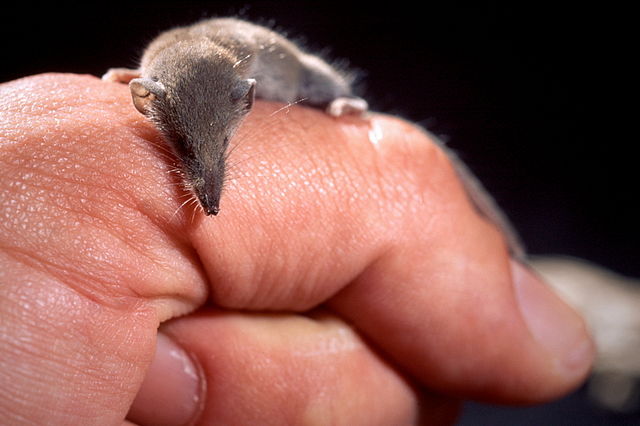
What is the smallest mammal? The Etruscan shrew is the smallest mammal in the world right now.
Etruscan means “of Etruria”, which was an ancient group of people that lived in central Italy from roughly 900 BC until 27 BC when it was dissolved into the Roman Empire. Rome was heavily influenced by Etruria and there is a strong likelihood that Rome was founded by Etruria and the first several kings of Rome were actually Etruscan. However, why this particular shrew is called the Etruscan shrew, I do not know.
There have been smaller mammals, but the Etruscan shrew is currently the smallest. It weighs about 1.8 g and is about 4 cm long, 6.5 cm if you count its tail. There was another, now extinct, shrew called the batodonoides vanhouteni that was only 1.3 g and smaller than the Etruscan shrew, but it disappeared about 53 million years ago and the only evidence of its size comes from a fossil of some of its teeth and part of its jaw.
So, why is the Etruscan shrew so small and how does it survive? Its size is down to evolution. We can talk about the advantages and disadvantages of animals being small, but the fact that it is small proves that there are advantages that have helped it reproduce. If being that size were more of a disadvantage than an advantage, the chances are that it would have evolved differently. Anyway, there are advantages to animals being small. Smaller animals mature more quickly than larger ones and can reproduce more often. That means they evolve faster as well. Smaller animals are lighter and more agile than larger ones. It is also easier for smaller animals to hide and avoid prey. Smaller animals need to eat less, which makes it easier to find food. They can also hibernate more easily.
Because Etruscan shrews are so small, they have several adaptations to survive. The biggest problem for them is that their size increases the likelihood of hypothermia. All animals lose heat through their surface and the amount of heat they lose is dictated by their surface-area-to-volume ratio. The larger an animal becomes, the lower its surface-area-to-volume ratio becomes. This seems counterintuitive. If a cube has sides of 1 cm, then it has a surface area of 6 cm2 and a volume of 1 cm3, giving it a surface-area-to-volume ration of 6:1. If you increase the length of the sides to 3 cm, then it has a surface area of 54 cm2 and a volume of 27 cm3, giving it a surface-area-to-volume ratio of 2:1. That is why elephants have such large ears. They generate more heat than they can lose through their surface area. Their large ears increase their surface area, slightly changing their surface-area-to-volume ratio. Etruscan shrews have such a high surface-area-to-volume ratio that they lose almost all of their heat through their skin. To counteract this, they have to have a very high metabolism because they must burn several times more energy than an elephant to keep their skin at the same temperature.
Warm-blooded animals produce heat by metabolizing the food they eat. When they convert the food into energy, a byproduct is heat, which heats their bodies. Moving the muscles also produces heat. Etruscan shrews have to eat up to 2 times their body weight in food every day. They mostly eat insects, larvae, and earthworms, so food is plentiful. They also move their muscles incredibly quickly to produce heat. Their high metabolic rate means they need to use more oxygen, which in turn means that they need to breathe very quickly and have a high heart rate. They breathe about 13 times a second and their heart rate is 1,500 beats a minute.
Etruscan shrews live in warm areas, but if the temperature drops, they are at serious risk of dying. To combat this, they can lower their body temperatures to 12℃ and lower their heart rate. They also do something called Dehnel phenomenon, which means they can shrink their brain by 28% and their organs shrink as well. Once the temperature rises, the shrews come out of this state and their brains and organs regrow. The theory on why this happens is that reducing the brain size and organ size cuts down on the number of calories needed. It is also possible that they are consuming their brain matter and organs while they cannot eat. Either way, it is a pretty impressive talent to have. And this is what I learned today.
Image By Trebol-a – Own work, CC BY-SA 3.0, https://commons.wikimedia.org/w/index.php?curid=4607913
Sources
https://www.sciencefocus.com/nature/top-10-earths-smallest-mammals
https://en.wikipedia.org/wiki/Batodonoides_vanhouteni
https://en.wikipedia.org/wiki/Etruscan_shrew
https://worldbuilding.stackexchange.com/questions/47698/what-are-the-evolutionary-advantages-to-size
https://en.wikipedia.org/wiki/Etruscan_civilization
https://ferrebeekeeper.wordpress.com/tag/metabolism/

Pingback: How do flies perceive time? | I Learned This Today